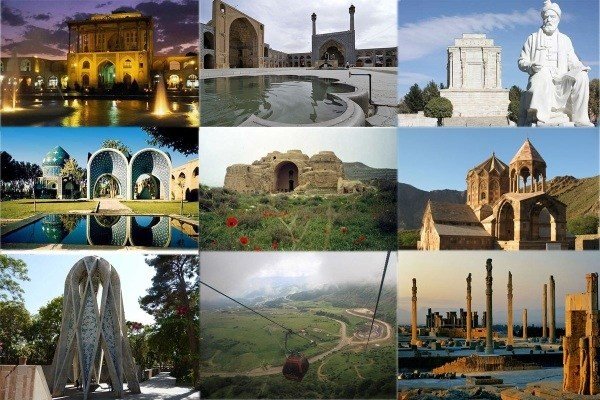
Treatment in Iran
October 10, 2020
Number of dental implant
November 8, 2020Tourism in Iran
The land of Iran has great tourism potential by taking advantage of its historical and cultural backgrounds and its natural and living characteristics. The remaining historical monuments from different periods of human settlement on the Iranian plateau, along with its many coastal, mountain, desert and desert landscapes, as well as historical and cultural monuments provide a range of different motivations for visiting Iran. In addition, today Iran, as an active political hub in the Islamic world, has attracted the attention of many in the world. Therefore, the main motives for visiting Iran can be summarized in political, social, Hajj, cultural, historical, natural and recreational motives.
Certainly, having such fertile ground for travel to Iran requires accommodation and food facilities commensurate with the desired travel facilities. Fortunately, in this regard, Iran, as far as possible, provides the necessary facilities with favorable conditions for those tourists who travel to Iran with various motives.
History of tourism in Iran
The land of Iran with its historical, artistic and cultural heritage is definitely the best destination for tourists in the Old Testament. Although the exact number of tourists who traveled to Iran before Islam is not known, what is certain is that the tourists who traveled to Iran after Islam and wrote their testimonies in their travel letters. The most famous foreign tourists who visited Iran and left a business called Namah Tourism are:
Ibn Hawqal, an Arab traveler, came to Iran in the mid-fourth century AH and wrote his testimony on Iran in a book entitled “Surat Al-Ard.”
Al-Maqdisi, the author of “The Best Division of Oldest Knowledge,” has traveled and traveled in most Islamic countries, including Iran, and spoke about Iranian cities in his book.
Yagut Hamwi, author of the book “Dictionary of Nations” in geography (the beginning of the seventh century AH), who traveled to Iran and described the land of Iran.
Ibn Battuta is from Tangiers in Morocco, and he traveled to Iran and on his trip he mentioned and described different parts of Iran, including its cities.
Abu Delaf, a famous Arab traveler, poet and geographer, who traveled to different cities in Iran from 331 to 341 AH, mentioned the historical monuments of Isfahan in detail in his writings.
Among the European and non-Islamic tourists who traveled to Iran, the most famous are as follows:
Six tourists also came to Iran during the Safavid period and talked about the social status of Iranian men and women on their travels.
Pietro Delaval, a famous Italian tourist and architect who came to Iran during the Safavid era, visited Isfahan and wrote on his trip about all the monuments and buildings in Isfahan and the architectural value of each.
Jean Chardin Faris Jean Chardin, a famous French tourist who came to Iran during the Safavid era and stayed in Isfahan for some time, claimed on his trip that he knew Isfahan better than London.
Engelbert Kempfer, a German tourist, came to Iran in 1684. His trip contains valuable geographical information about Iran.
Tavernier, a professional French traveler, traveled to Iran six times between 1041 and 1078 AH, and on his trip criticized the ancient tapestry of Isfahan.
Anthony Shirley came to Iran from England with his brother Robert Shirley during the reign of Shah Abbas. On his trip, he talked about the excellent mosques and religious beliefs in Iran.
Mrs. Dioulafova, who traveled to Iran with her husband, artist Marcel, who was a famous architect and painter in the late thirteenth century AH. In his book on travels, he described Isfahan and its historical monuments and described other cities in Iran.
Henri Rahi Dalmani, a French tourist who came to Iran in 1324 AH, left a travel story entitled from Khurasan to Bakhtiari.
Berlotti, the famous French traveler and writer, traveled to Iran in 1321 AH. Author books on the travel entitled “Toward Isfahan”
– Eugene Flanden, a French traveler and painter who came to Iran during the Qajar period, and his trip is accompanied by a photo album of Iranian antiquities.
Lawrence Lockhart studied in Iran and wrote a book on Iran entitled “The Extinction of the Safavid Dynasty and the Days of Afghan Domination.”
– George Clark, a famous urban planner who traveled to Iran and says about Isfahan, in his opinion, that Isfahan should be considered the largest and most famous ancient city in the world after Beijing.
Establishing tourism organizations in Iran
For more than half a century, the tourism industry was formally formed in order to introduce the glories of Iran and the ancient civilization to this ancient land, and for the first time in 1314, an office was established in the Ministry of the Interior called the “Tourism Department”. The activity of this office was limited to publishing publications in the form of small pamphlets, with the aim of guiding tourists and introducing Iran in terms of geography, politics and society, as well as preparing and distributing them. After Shahrivar 1320, the aforementioned office was replaced by the “Supreme Council for Tourism”. The council meets once a week at the Ministry of Interior and is managed by the ministry’s political section.
In the year 1333 AD, the government considered the importance of attracting foreign tourists because of its economic aspects and to reinforce the foundations of good understanding between people in different countries, and the Department of Tourism was re-established in the Ministry of the Interior. This office has succeeded in its new period of activity
Matt became the basis for many areas of tourism development in the country, including a proposal to draft laws regarding the entry and exit of foreign nationals.
In the year 1340, the Supreme Council for Tourism was composed of 12 representatives of ministries and government institutions and three people with knowledge and insight in tourism, and their mission was to define the policy and executive plans of the Tourism Department of the Ministry of Interior, and mainly in the field of tourism, the state was under high-level supervision.
The creation of this organization led to a series of stabilization activities, and although developments were unorganized and unplanned, they increased the interest of foreigners in visiting Iran, and there came a time when there was a shortage of suitable catering facilities and response equipment. At the request of tourism, we feel the need to take basic measures in this area, so to start more serious and effective measures in
In the field of tourism, the first step was to establish an appropriate organization to coordinate and control all tourism activities in the country. On April 7, 1963, an organization called the “Tourist Attraction Organization” was created. The Tourism Attraction Organization has prepared very effective and basic measures for the development of the tourism industry in the country by preparing, organizing and implementing large-scale plans and programs.
In 1974, the Tourist Attraction Organization merged with the then Ministry of Intelligence, which began operating under the name of the Ministry of Information and Tourism. The Iranian Tourism Administration is managed by four joint-stock companies, which are the Iranian Tourist Facilities Company, the Iranian Patrols Company, the Iran Homes Center Company and the Tourist Centers Organization Company for Winter Sports under the supervision of the Ministry of Information and Tourism.
In 1979, in order to prevent the overlapping of tasks and coordinate all activities and issues related to tourism in order to implement the policy of austerity, in accordance with the approval of the Revolutionary Council on 8/21/1358, the four companies were merged and named the Iranian Tourist Centers Organization. from the past. The organization manages the operation of accommodation units in the form of hotels, motels, guesthouses, camps, cottages, tents, restaurants, cafes, ski slopes, coastal facilities, mineral baths, facilities and centers for winter sports and any other suitable place that is responsible for Iranian tourism. At present, the Deputy Minister of Tourism and Hajj at the Ministry of Culture and Islamic Guidance and the Tourism Organization and Recreation Centers of the Foundation for the Disadvantaged and Veterans of the Islamic Revolution undertakes all activities of the tourism industry in the country, in cooperation with other relevant bodies across the country. Tourism and achieving the desired goals. The organization of the Tourism and Hajj Agent includes the following five units:
General Directorate of Tourism Services Supervision
Iranian Tourism Studies and Research Center
Planning and Technical Affairs Office
Higher Education Center for Iranian Tourism and Tourism
Center for Iranian Cultural Affairs abroad
With the end of the imposed war and the relative calm of the region, the government of the Islamic Republic of Iran, by providing the right conditions, made unrelenting efforts to launch and develop the country’s regular tourism.
Iranian tourism markets
Tourism markets refer to a group of countries whose tourist destination is Iran. Until the last decade, the countries of the southern Persian Gulf, Pakistan, Afghanistan, as well as Western Europe, the United States, Canada, Southeast Asia and India were the most important tourist destinations for Iran, on average more than the total number of foreign tourists. In the year 1355, its population was about 657 thousand people, half of whom were citizens of these countries by air (Mehrabad, Shiraz and Abadan airports) and less than the other half through the land borders (Khorasan, Khosravi, Bazargan, Mirjaveh, and Julfa), the rest entered Iran through the southern ports of the country, These are Abadan, Khorramshahr and Bandar Abbas, but this influx of tourist movements has changed since then, so that Turkey, the former Soviet Union, Pakistan and India, respectively, became the largest number of tourists to Iran, followed by Germany, Italy and Japan, followed by other countries such as the United Arab Emirates. Britain and France.
Tourist attractions in Iran
Due to its historical eras and its continuous social and cultural endeavors, Iran has many attractions that can satisfy a wide range of tourists’ expectations and opinions. Every tourist who has any motivation to travel to Iran can find desirable attractions in Iran according to his preferences, tastes and plans. We should not forget that the best way to get to know the land and the people in any country is to get to know the people of the streets and markets and prove their presence with them directly.
Iranian families are mainly hospitable and gracious. With a brief introduction, you can enter the Iranian family and learn about their way of life, their livelihood, their way of thinking, their social insight, and many other characteristics that were not included in the writings.
According to the different motives that a travel to Iran can have, the tourist attractions of Iran can be divided into three main parts, the natural attractions, the cultural attractions and the religious monuments, each of which is briefly described below.
Natural attractions and landscapes
Cultural, artistic and historical monuments
Religious shrines and Hajj centers
Natural attractions and landscapes
The special geographical location of Iran and its location
It enjoys natural attractions such as tall and beautiful mountains such as Soblan and fertile and stunning plains and plains such as Naz Plain, Moghan Plain, Arjan Plain, lush forests and landscapes such as Golestan National Park, Nur and Sisangan Park, forests, large caves and strange like Ali Sadr Cave, and water rivers such as Karun River, Ziandrod, Cefedro, Jjrod, swamps and wonderful halls such as Anzali Lagoon, Myankale and Wetland which are important environmental resources for the country for wildlife, dry deserts and huge deserts with unique landscapes are individual and beautiful lakes such as Lake Tar, Lake Kahr and Lake Urmia with beautiful islands and a refuge for migratory birds of global importance and mineral water Varied with various healing properties such as Ardabil Sarin mineral water, local mineral water, presence of water and different climates (dry, wet, cold, hot, temperate, Mediterranean) in different regions that caused that in the land of Iran on every day of the year there are four seasons, spring, Summer, autumn and winter simultaneously. In short, the beautiful and interesting scenery and natural features of this land are so abundant that the pen is unable to express all these scenes, and these are just a few examples of the attractions which, due to the necessity of the subject, only a brief name is mentioned.
Cultural, artistic and historical monuments
The ancient history of Iran and its location on the Silk Road and the road between East and West have made Iran one of the most important poles of human civilization in the world. The original ancient culture and its merging with Islamic culture has increased its importance, especially in recent years, which has increased the curiosity of sociologists, sociologists, researchers and tourists to visit and study this land. Many remaining works and signs of the development of Iranian culture and civilization can be used as tourist attractions. The summary of these valuable works: Remains left in Hamadan, Kashan Silk Hill, Marlik Rudbar, Chogazenbel Pasargad, Sousse, palaces and palaces and huge and magnificent old halls such as Persepolis and Apadana, old palaces, beautiful mosques such as the Great Mosque of Yazd, Sheikh Childah Mosque, Kohrshad Mosque, schools Historical buildings, towers, windbreaks, minarets such as the minarets of Isfahan, castles, baths, such as the Kanjali Khan bath in Kerman, famous gardens, water tanks, caravans, tribal culture, handicrafts, such as carpet weaving, inlays, gold weaving, inlay work, engraving And the like, which is world-famous and made the name of Iran private and the cities of Isfahan and Shiraz private and public. The ancient cities of Iran, with their traditional texture, monuments, historical buildings, indigenous culture and ancient customs, along with the aforementioned, are the pillars of the artistic, historical and cultural attractions of these borders and the environment that study, define, protect and advance that will add to the prosperity and expansion of the tourism industry in the country to the world and will enhance its culture.
Religious shrines and Hajj centers
With the spread of Islam in Iran, the shrines of the imams gradually became pilgrimage centers for the people. After this process, the shrines of the religious leaders created the main building for each place by building appropriate courtyards. One of the manifestations of people’s interest and devotion in following the philosophy of the Imamate is the construction of tomb buildings and the Imamzada’s architecture. The most prominent artists of their era used their taste and genius through the use of the facilities available in the construction and gilding of religious and pilgrim centers, which led to the existence of a large number of pilgrimage sites in Iran. The Islamic Hajj centers in Iran are divided into two categories, the first group of centers that have global and local Hajj value, such as the shrine of Imam Reza (peace be upon him) in Mashhad, the shrine of Imam Masumah (peace be upon him) in Qom and the shrine of Imam As for Khomeini (peace be upon him) in Tehran. The second category of the most valuable centers for local and regional pilgrimage, which are located in different regions of the country, the most important of which are:
The shrine of Hazrat Ahmad bin Musa bin Jaafar (peace be upon him) known as Shahshiragh in Shiraz
The tomb of Hazrat Abdul Azim (PBUH) and Hazrat Hamzah bin Musa Al-Kazim (PBUH) in Al-Rai.
The tomb of Sayyid Jalaluddin Ashraf bin Musa al-Kazim (peace be upon him) in Ashrafieh, Gilan
The grave of Daniel the Prophet (may God bless him and grant him peace) in Susa.
Many mausoleums in Iran became urban centers as a result of the development of their role in Hajj. Often around the shrine, the mausoleums became the focus of some service and commercial activities and became independent centers as the number of pilgrims increased. Therefore, the location of these shrines is in many cases in the center of cities.
In addition to the Shiites, there are followers of other religions in Iran, such as Sunnis, Armenians, Jews and Zoroastrians, and all of them have their own religious centers.
The most important Sunni religious centers are Turbat Sheikh Jam (the tomb of Sheikh Jam) which is located in Khorasan and the other is Sanandaj Grand Mosque. Armenians travel to the Tatavos Church in Siah Chesme, near Mako, in the summer, in addition to the 13 Julfa churches in Isfahan, which are of interest to Iranian Armenians, there are many churches in Azerbaijan, the most beautiful of which is Saint Stephen’s Church. Iranian Jews visit the tomb of Esther (Astromrokhai) in Hamadan. Zoroastrians, most of whom live in Yazd and Tehran, go to Persepolis, Naghish Rostam, Taq Bustan, Bastun, and Shek (in Yazd) every year to hold their celebrations. Zoroastrians pay a lot of attention to the ancient fire temple at Azargishab in Takht-e Solomon, the Kashmir Tower in Khorasan and Lake Urmia, a temple sacred to them.
Total places
Religious Iran, as one of the centers of pilgrimage, has an effective role in tourism, Hajj and entertainment activities and thus in developing domestic tourism at various levels, so the necessary facilities must be provided for its prosperity and expansion more than ever before.
Iran as an Islamic country
The Islamic influence on Iran in the mid-7th century CE followed the collapse of the Sasanian Empire. Since then, a new era in Iran’s history began, which brought about radical changes in the social, political and religious conditions of the government and people. Iranians, dissatisfied with the social inequality of the Sasanian era, restored their lofty ideals in Islamic slogans. Soon they converted to Islam and tried to spread it and deprive it of its culture. Although they converted to Islam, the Iranians never concealed their opposition to the Umayyad and Abbasid caliphs. They also stood to weaken and oppress the Iranians, and supported the family of the Prophet, may God’s prayers and peace be upon him, to establish a government based on the imamate, and to strengthen non-Iranian elements. The continuing eroding wars between the local sultans weakened their power and paved the way for the domination of foreign tribes in Central Asia such as the Seljuk Turks, the Mongols and the Timurids. During the Safavid period, the Third Great Empire of Iran was established and the Shiite religion was recognized, which until then had imposed restrictions on its adherents. The dynamic nature of the Shiite religion and its political and social commitments steadfastly preserved Iran’s independence and national identity in the face of the heavy blows of the Ottomans, and Iran was once again able to stand up to the claim of Muslim patronage as a powerful political and religious force. . The decline of the Safavids limited the real scope for Islam to function as an active religion. With the arrival of Afshariya and Zend
To power, there was no major change in the process. The Qajar era is associated with the expansion of the influence of Russian and British foreign powers in Iran. These colonists recognized the dynamic and militaristic nature of Islam and spared no effort to eradicate or distort it. The influence of Islam in the heart of Iranian society has been so deep that in the contemporary history of Iran, many social movements such as the tobacco movement, the constitutional revolution, and even the nationalization of the oil industry, have had important religious forces in political unity and the cohesion of the people.
Finally, religious efforts and tensions in society intensified, in the form of a huge slap in the face to the popular movement, on June 6, 1963, in the form of the Islamic Revolution and led by Imam Ruhollah Khomeini. My Islam ended on April 3, 1979. Throughout her life history, the people and land of Iran provided favorable conditions for the growth and diffusion of the indigenous culture, and just as much, she rejected the culture without authenticity. The choice of the Shi’a religion as the Prophet’s Islam and his pure lineage stems from this very nature. After the acceptance of Islam in Iran, Islamic art and architecture, influenced by the culture and art of the inhabitants of this region, took a certain shape and form during different periods and found its position as an independent model. Islamic and Iranian culture, literature, and sciences went hand in hand on the path of glorification and prosperity, so that Iran, even at the height of the centers of the caliphate, remains an important center for the cultivation of science and art. Islam arose out of such a message. We should not forget that the Iranians, by choosing the path of Shiism, have a very important role in spreading Islam and its cultural richness in the Islamic world.
The influence of Islam in Iran The social and political obstacles to the development of culture in the Sasanian era were dominant in society, and they were removed and sought to establish political stability in Iranian societies and scientific circles. Iranians have made great efforts to contribute to the development of the Persian language and the development of the Arabic language and literature, which is key to understanding the concepts of the Qur’an. Theological schools and cultural centers in Iran have provided great celebrities and honors to the scientific community of the world. The cultural and scientific fields of Khorasan, Rai, Shiraz, Tabriz, Maragha, Jundishapur and Isfahan as active examples of scientific centers in Iran and the Islamic world have shown great activity during their lives and great personalities and scholars such as Zakaria Al-Razi, Abu Ali Sina and Al-Farabi Nasha Al-Ghazali, Abu Rayhan Al-Biruni, Khawaja Nasir Al-Din Tusi, Saadi, Hafez and Rumi in these Scientific societies.







